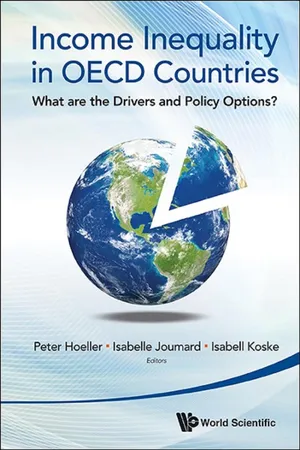
Income Inequality In Oecd Countries: What Are The Drivers And Policy Options?
What are the Drivers and Policy Options?
- 236 pages
- English
- ePUB (mobile friendly)
- Available on iOS & Android
Income Inequality In Oecd Countries: What Are The Drivers And Policy Options?
What are the Drivers and Policy Options?
About This Book
This book provides a comprehensive review of income inequality issues in the OECD in a cross-country setting. It presents a wealth of data and analysis on the formation of inequality and identifies groups of countries that share similar inequality patterns. It also reviews developments at the extremes of the income distribution, namely poverty, top incomes as well as the distribution of wealth. An important contribution of the book is the careful examination of the determinants of the income distribution, such as globalisation and technical progress as well as the effect of a wide range of economic policies that shape the distribution of income. These include in particular labour market regulations, household taxes and transfers as well as in-kind public services. It also sheds light on an under-researched issue: do policies aimed at boosting economic growth raise or reduce income inequality?
Errata(s)
Errata (18 KB)
Contents:
- Introduction (Peter Hoeller and Mauro Pisu)
- Mapping Income Inequality Across the OECD (Peter Hoeller, Isabelle Joumard, Mauro Pisu, and Debbie Bloch)
- The Distribution of Labor Income (Isabell Koske, Jean-Marc Fournier and Isabelle Wanner)
- Income Redistribution via Taxes and Transfers (Isabelle Joumard, Mauro Pisu and Debbie Bloch)
- Poverty (Mauro Pisu)
- Top Incomes (Peter Hoeller)
- The Distribution of Wealth (Kaja Bonesmo Fredriksen)
- Conclusion: Growth-Enhancing Policies and Inequality (Isabelle Joumard and Isabell Koske)
Readership: Graduate students and academic researchers, financial analysts and experts interested in income inequality, bureaucrats and policy makers working in the finance ministries, especially in OECD countries.
Frequently asked questions
Information
Table of contents
- Cover Page
- Half Title
- Title Page
- Copyrights
- Contents
- Disclaimer
- Chapter 1. Introduction
- Chapter 2. Mapping Income Inequality Across the OECD
- Chapter 3. The Distribution of Labor Income
- Chapter 4. Income Redistribution via Taxes and Transfers
- Chapter 5. Poverty
- Chapter 6. Top Incomes
- Chapter 7. The Distribution of Wealth
- Chapter 8. Conclusion: Growth-Enhancing Policies and Inequality
- About the Authors
- Index